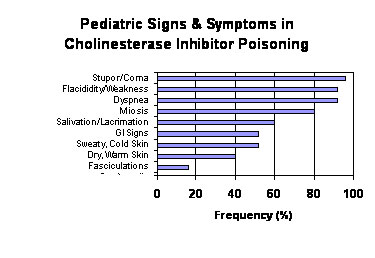Part 4: The Cholinergic Toxidrome
Section 8: Signs and Symptoms: Differences in Pediatric Cases
On This Page
Learning Objectives
Upon completion of this section, you should be able to
- identify how the clinical presentation in pediatric cases of the cholinergic toxidrome differs from that in adults.
Differences in Pediatric Cases
Pediatric cases may present with clinical findings that are different than in adults. Examples include:
- Bradycardia, fasciculations, lacrimation, and sweating are less common. (Sofer, Tal et al. 1989)
- Common presenting signs are lethargy, coma, seizures, flaccid muscle weakness, miosis (pupillary constriction), tachycardia, and excessive salivation. (Sofer, Tal et al. 1989; Tareg et al. 2001)
- The predominant effects may be nicotinic instead of muscarinic, manifesting mainly as neuromuscular weakness (Tareg et al. 2001) and CNS effects. (Erdman 2004)
- While generalized seizures are not typical in adults except in severe nerve agent poisoning or massive doses of other organophosphorus compounds, they are common in pediatric patients. (Tareg et al. 2001)
Note: Neuromuscular weakness is easy to overlook in a small child — who may appear very quiet and still — unless muscle tone is specifically assessed. (Tareg et al. 2001)
Pediatric Signs and Symptoms
The frequency of pediatric signs and symptoms in cholinesterase poisoning is shown in the Figure 9 below. (Sofer, Tal et al. 1989)

Figure 9. Pediatric signs and symptoms. Data from: Sofer S, Tal A, Shahak E. Carbamate and organophosphate poisoning in early childhood. Pediatric Emergency Care. 1989; 5:222-225.